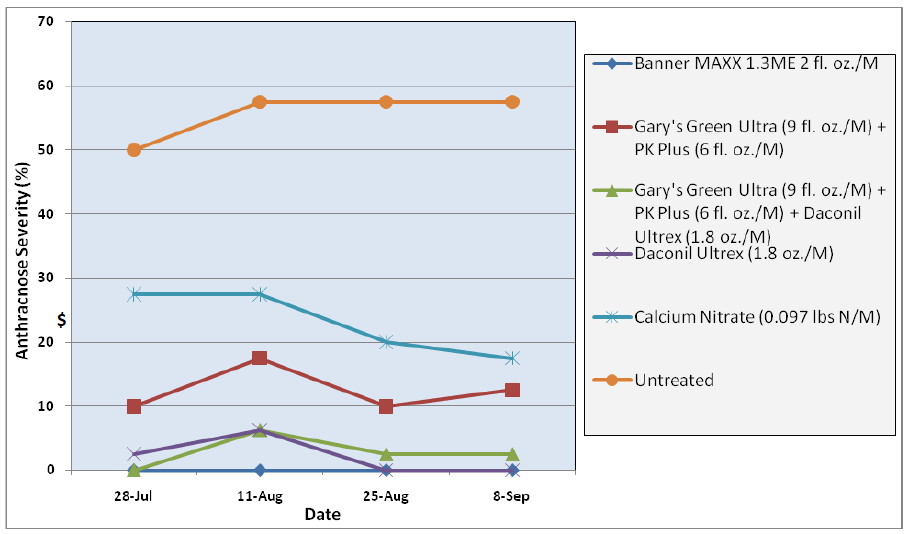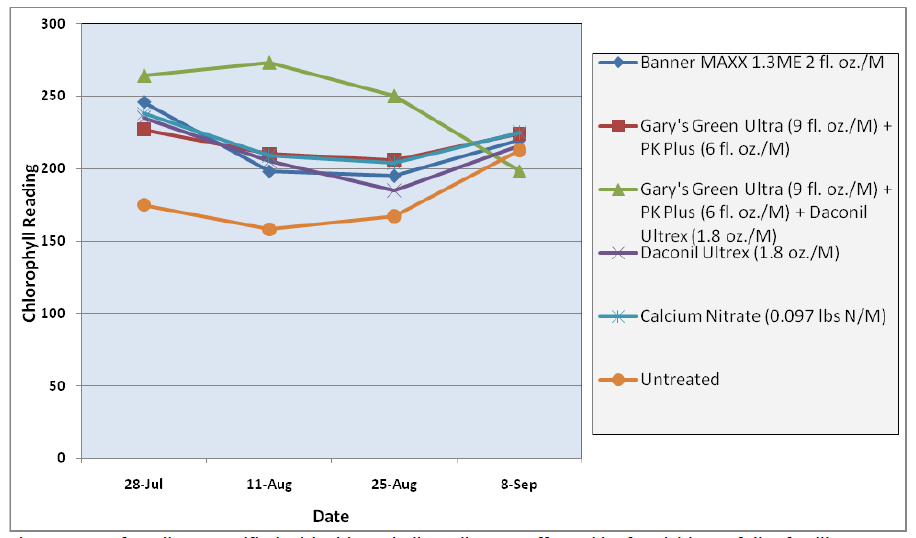Nitrogen Phosphite Containing Fertilizers for the Management of Anthracnose
Research Topic: Evaluation of nitrogen phosphite containing fertilizers for the management of anthracnose in southern California (2009), F. Wong, University of California Riverside
Abstract
Anthracnose (Colletotrichum cereale) has become a major disease problem on annual bluegrass (Poa annua) putting greens. An integrated and preventative approach remains the most effective management strategy for lessening the incidence and severity of this disease, including the utilization of appropriate cultural practices, and a rotational fungicide program. Low mowing heights, low N or unbalanced fertility, and the onset of specific environmental factors increase the risk for anthracnose development. The objective of this trial was to 1.) Determine the effect of foliar nitrogen (N) and phosphite (H3PO3) on overall turfgrass quality (chlorophyll ratings) and the incidence and severity of anthracnose symptoms and 2.) Determine the effect of foliar nitrogen (N) source and rates, phosphite (H3PO3), and low label rates of chlorothalonil applied every seven (7) days on anthracnose incidence and severity. Foliar nitrogen (N) [Gary’s Green Ultra® – 13-2-3 (0.097 lbs N)] and phosphite (H3PO3) [P-K Plus® – 3-7-18 + 14% potassium phosphite (K2HPO3)] (GG + PKP) provided excellent disease suppression (83% on 28-July and 25-Aug) on each rating date which was significantly different than the control and statistically similar to fungicide treatments which included Banner MAXX® (2 fl. oz./M) and Daconil Ultrex® (1.8 oz./M) (Figure 1). The addition of Daconil Ultrex (1.8 oz./M) to the foliar N and phosphite treatment resulted in an even greater reduction in the disease (Figure 1). When applied separately, foliar N provided better disease suppression than potassium phosphite (data not shown). The observed reduction in anthracnose by spoon feeding N was not affected by N source (data not shown). Increasing the N rate from 0.097 to 0.16 lbs N/M lessened the disease pressure; however this difference was not statistically significant. In addition, the higher rate of N (0.16 lbs N/) applied every 7 days in this study may compromise putting green playability (ie. speed). As a general observation and based on trials at different locations, certain treatments applied every 7 days (CA, 2009) appear to provide better anthracnose suppression than the same treatments applied every 14 days (NJ, 2009), specifically for the GG + PKP treatment (64% reduction NJ – 14 days; 83% reduction CA – 7 days) and Daconil Ultrex (1.8 oz./M) applied alone (73% reduction NJ – 14 days; 100% reduction CA – 7 days). The GG + PKP + Daconil Ultrex (0.097 lbs N/M) treatment provided the highest chlorophyll readings during this study, significantly higher than N applied alone in the form of CaNO3 (0.097 lbs N/M) (Figure 2). Based on these results, utilize a consistent N spoon feeding approach, P-K Plus (potassium phosphite) and Daconil Ultrex (1.8 oz/M) (7-14 application interval) as part of an integrated approach to anthracnose management. N source had little effect on the extent of disease reduction, however increasing the N rate will reduce disease symptoms. Only increase the N rate to the point where playability does not suffer. Initiate this program prior to the onset of visual disease symptoms. Rotate fungicide chemistries, apply Primo MAXX® and sand topdressing routinely, and do not over or under water for added control.
Daconil Ultrex®, Primo MAXX®, and Banner MAXX® are registered trademarks of Syngenta Professional Products.

Figure 1. Turf area infested by anthracnose (%) as affected by fungicides, a foliar fertilizer program containing potassium phosphite, soluble nitrogen (N) and a combination of a foliar fertilizer + potassium phosphite and fungicides applied every 7 days.

Figure 2. Turf quality quantified with chlorophyll readings as affected by fungicides, a foliar fertilizer program containing potassium phosphite, soluble nitrogen (N) and a combination of a foliar fertilizer + potassium phosphite and fungicides applied every 7 days.